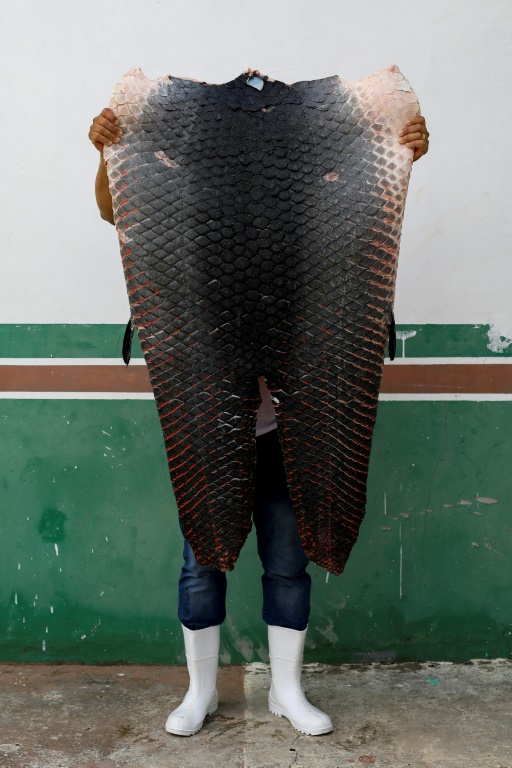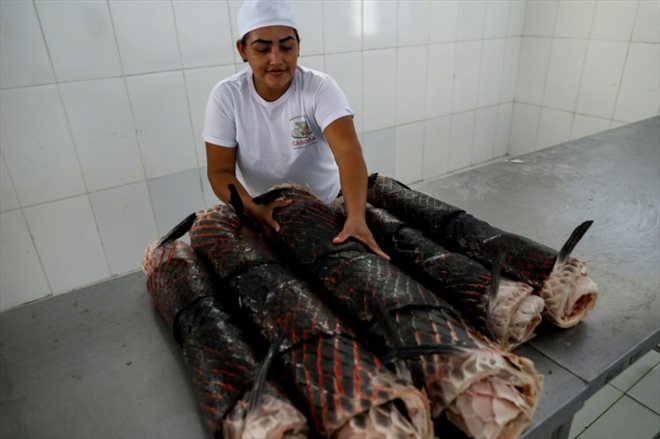A fisherman carries a Pirarucu (Arapaima gigas) in the Mamiraua Sustainable Development Reserve in Fonte Boa, Amazonas state, Brazil, on November 4, 2022 (AFP/MICHAEL DANTAS)
The pirarucu, a giant fish with tasty flesh nicknamed “the cow of the Amazon”, is the privileged target of poachers in the knot of the three borders between Brazil, Peru and Colombia, land of pioneers and all kinds of trafficking.
But it is also the subject of a local fish farming project aimed at protecting this precious resource, while preventing predation by illegal fishermen in the indigenous territory of the Javari Valley.
For the Kanamari, one of the seven ethnic groups identified in this river valley, the mythical story of the pirarucu (Arapaima gigas) is told as follows: “a tree leaf that fell into the water and became a giant fish”, tells AFP the cacique Mauro da silva Kanamari.

A fisherman with a pirarucu (Arapaima gigas) at the Mamiraua Sustainable Development Reserve (RDS) in Fonte Boa, Amazonas state, Brazil, on November 5, 2022 (AFP/MICHAEL DANTAS)
For a long time anonymous food of the Amerindians living in these confines of the immense Amazonian forest, the pirarucu now features prominently on the menus of gourmet restaurants and other “fusion food” in Rio, Bogota or Lima.
A success that makes him unhappy: his purchase price breaks records on the illegal markets and clandestine ice cream sheds of Atalaia do Norte, Benjamin Constant, Tabatinga (Brazil) and its neighboring twin town of Leticia (Colombia), main localities of the triangle of the three borders.
– Piranha resistant –
The pirarucu is one of the largest freshwater fish on the planet: omnivorous, it can reach up to 3 meters in length, weighing more than 200 kg.

Fishermen unload pirarucus (Arapaima gigas) at a wharf in the Mamiraua Sustainable Development Reserve (RDS) in Fonte Boa, Amazonas state, Brazil, on November 4, 2022 (AFP/MICHAEL DANTAS)
Its scarlet dorsal fin tapering towards the tail, along with its awkward flattened head and bulging eyes give it the look of a prehistoric fossil.
Everything is good about pirarucu, the flesh and fillets of course, succulent, almost boneless and without the usual muddy taste of freshwater fish.
We use even the guts, its leather and its scales (resistant to attacks by piranhas) which are resold as key rings for tourists.
Its fishing is done with a net and a harpoon, the fish coming to the surface to breathe at least every twenty minutes. It is seen at the beginning of the year – when the waters are at their highest – in the lakes and ponds of the meanders of the Amazon and its tributaries.

Fishermen transport Pirarucu (Arapaima gigas) on a boat in the Mamiraua Sustainable Development Reserve (RDS) in Fonte Boa, Amazonas state, Brazil, on November 5, 2022 (AFP/MICHAEL DANTAS)
Victim of overfishing throughout the Brazilian Amazon, the pirarucu almost disappeared in the 90s, until the implementation of strict regulations in 2004 by the environmental police, Ibama.
In the state of Amazonas, its fishing is strictly regulated. It is forbidden in the Javari reserve, except for the natives’ own consumption.
– “Beautiful and good” –

A fishmonger cuts the flesh of a pirarucu (Arapaima gigas), in the Mamiraua Sustainable Development Reserve (RDS) in Fonte Boa, Amazonas state, Brazil, on November 7, 2022 (AFP/MICHAEL DANTAS)
Supported by a Brazilian NGO (CTI) and managed directly by the Kanamari Amerindians, a natural fish farming project is currently being tested in Middle Javari, which is inspired by sustainable management successfully implemented elsewhere in the country. .
“The idea is that the natives feed themselves, meet their needs, while protecting their territory,” Thiago Arruda, local CTI official, told AFP.
This “manejo” project, according to its Portuguese name, “is very important for us”, emphasizes Bushe Matis, general coordinator of Univaja, the Union of Indigenous Peoples of the Javari Valley.
“People used to fish haphazardly. Now we are going to take care of the lakes and fishing areas, to always have fish in the future, while contributing to the fight against intrusions”, he wants to believe.

A fishmonger shows the skin of a Pirarucu (Arapaima gigas), in the Mamiraua Sustainable Development Reserve (RDS) in Fonte Boa, Amazonas state, Brazil, on November 7, 2022 (AFP/MICHAEL DANTAS)
But the task is difficult, perilous, in the face of illegal fishermen. “They are the ones who are stealing from us!” castigates Joao Filho Kanamari, one of the project coordinators.
Organized into a vigilance group, the Kanamari play the card of awareness and dialogue, in the face of often aggressive and possibly violent smugglers.
After five years of gestation, the project is coming to an end this summer 2023, with a final count of the pirarucus and the first captures. Ibama has already given its approval, and authorized the marketing of future catches.
But the pitfalls remain numerous. Logistics for example, with the organization by the rustic Kanamari of a cold chain from the depths of the forest. Or the thorny tree shares benefits within the community.

A fishmonger rolls skins of Pirarucus (Arapaima gigas) at the Mamiraua Sustainable Development Reserve (RDS) in Fonte Boa, Amazonas state, Brazil, on November 7, 2022 (AFP/MICHAEL DANTAS)
The “manejo” also arouses the growing desire of local political and economic actors “not necessarily well-intentioned and probably involved in illegal fishing networks”, worries a promoter of the project.
In the meantime, the Kanamari praise in song this “beautiful and good” project. “The manejo is the future of our children!”, smiles the cacique Mauro.
© 2023 AFP
Did you like this article ? Share it with your friends with the buttons below.




